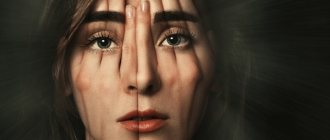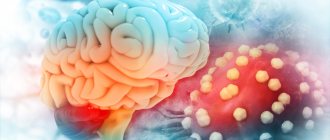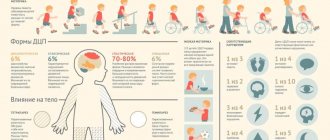Twilight stupefaction - what is it and how does it manifest?
A twilight state of consciousness is a mental state with deep disorientation, limitation of consciousness on certain objects or persons, accompanied by psychomotor restlessness and aggression.
An episode of twilight disorder of consciousness is subsequently replaced by complete amnesia; the person cannot remember how he behaved, what happened around him during the narrowing of consciousness.
In clinical practice, there are often cases when a person unknowingly leaves for another city or region. He subsequently describes his state as follows: “Sitting on the bus, I seemed to think or close my eyes for a few seconds... I didn’t understand how I ended up in a place unfamiliar to me. I asked a passerby, it turned out I was in another city...” However, not in all cases this violation is harmless; a person can unknowingly seriously injure or kill, and with frantic cruelty.
Twilight disorder of consciousness refers to disorders of higher mental processes. With the help of consciousness, a person learns about the world around him, himself, and adapts to changing environmental conditions.
Being in a clear consciousness, a person easily relates himself and the surrounding reality, soberly assesses his capabilities. In this case, they say that he is correctly oriented in location, time, surrounding situation and his own personality.
What happens during clouding of consciousness
Clouding of consciousness is its disintegration with a decrease in the level of perception of external stimuli and the filling of a person’s “internal space” with pathological psychoproductive phenomena. At the same time, a person’s behavior changes, which is determined by the depth of immersion in one’s own experiences and the visible response to them.
The main clinical signs of confusion are:
- detachment from the outside world, while the perception of ongoing events is fragmented and inconsistent, and the analysis of these external stimuli is sharply reduced;
- disorientation in space and time due to the patient’s immersion in his experiences, it is noted that the patient partially or completely does not recognize familiar people and familiar surroundings;
- disturbances in thinking with its incoherence, inconsistency, amorphism, fragmentation;
- memory deterioration to varying degrees, up to amnesia of everything that happens during the period of darkened consciousness, including one’s own experiences.
To diagnose confusion, all 4 of the above signs must be present. Hallucinatory and secondary delusional disorders are also often detected. Experiences during the period of stupefaction are perceived by the patient as real. They replace the events of the surrounding world or are felt as more vivid, absorbing all the patient’s attention. Sometimes this is accompanied by a lack of self-awareness and a feeling of alienation.
Individual memories of the experiences experienced may persist for some time, their vividness and detail depend on the type of disorder suffered. Subsequently, they lose relevance, but criticality towards them almost never reaches a sufficient level. But in some cases, the exit from the state of darkened consciousness is accompanied by complete amnesia for this period; the patient may note a failure in personal perception of time.
Main features
4 main signs of impaired consciousness:
- detachment from reality: a person does not understand what is happening around him, attention is narrowed to one or several objects, he is not interested in people and external circumstances,
- allo- and autopsychic disorientation of varying degrees of severity: impaired perception of place, time, one’s personality,
- thinking disorder: a person is unable to clearly express his thoughts and answer questions asked, speech is confused, incoherent,
- memory impairment: after the state is normalized, a fragment during which consciousness was narrowed falls out of memory.
Twilight disorder of consciousness is associated not only with disorientation, but also with various automatisms - stereotypical, sharp, repetitive movements, sometimes even of a professional nature: during a twilight disorder, a carpenter makes movements as if working on a machine, an operator continues to work on an assembly line, and a bus conductor – sell tickets to imaginary passengers.
As a rule, most often a person is in motor agitation, moves chaotically, movements are not purposeful and destructive in nature.
There are several types of mental automatisms: trance and fugue. During trance, ambulatory automatisms have a complex structure; movements from the outside seem quite consistent. However, these actions were not planned by the person himself; they are ineffective.
Most often, patients with this variant of twilight narrowing of consciousness are prone to moving, traveling in transport, and unknowingly leaving for another city or region. Outwardly, one notices a drowsy appearance and a certain confused detachment from what is happening. The trance can last from several minutes to several days.
A fugue is a sudden change of state with the need to escape or run. Movements are also aimless and unrelated to the environment. The fugue is short-lived, only a few minutes.
A narrowing of consciousness occurs suddenly against the background of emotional stress, anger, rage, fear. Both hallucinatory and illusory experiences at the height of affect are characteristic.
Twilight disorder can occur not only during the day. Disturbances that occur at night are called somnambulism or sleepwalking.
Delirium
Delirious stupefaction is characterized by the presence of predominantly psychoproductive symptoms. These include abundant hallucinatory and illusory disorders and the acute sensory delirium determined by them. In this case, true visual hallucinations predominate, although tactile and auditory deceptions of perception are also possible. Their content is usually unpleasant for the patient and is threatening in nature. These can be monsters, beasts of prey, skeletons, small animals and insects, small humanoid creatures. Hallucinations quickly replace each other; wave-like influxes of visions are characteristic.
Behavior is subordinated to emotions, patients are usually restless motorly up to the development of psychomotor agitation. Aggression is directed at hallucinatory images and can affect others. Affect is variable and determined by the content of hallucinations. Generally, anxiety, anger, and fear predominate, but transient states of curiosity and enthusiasm are possible. Preoccupation with hallucinations leads to complete or partial disorientation, and false orientation in space and time is often noted.
Delirium is a wave-like condition. It is characterized by lucid windows: spontaneous periods of lucidity, when the patient’s perception of the environment and the overall level of brain functioning improve. The condition also worsens in the afternoon with an increase in hallucinatory influxes in the evening and at night. Lucid windows most often occur after awakening; during them, the person is asthenized, partially oriented and moderately critical. In addition, delirium is characterized by stages of development, with each stage being reversible.
At the first stage, there are no hallucinations yet, but there are influxes of vivid memories, increased and uncontrollable associations, and distracted attention. The person is talkative, affectively unstable, not critical enough and is not always clearly oriented. His behavior becomes inconsistent, and his sleep is restless and superficial, with disturbing, overly vivid dreams.
At the second stage, illusions and pareidolia appear, disturbances of attention are aggravated with difficulty in perceiving the environment. The third stage of delirium is characterized by multiple true hallucinations and associated sensory delusions. Even when scene-like visual hallucinations appear, the feeling of their alienness remains. The patient does not become involved in imaginary events, but observes them or opposes himself to them. Behavior is subject to emotions, orientation deteriorates sharply.
The fourth stage is a severe disintegration of thinking with complete immersion in experiences and detachment from the outside world. Delirium at this stage is called muttering. The man shakes something off himself, makes picking movements, fidgets with the bed, and mutters for a long time. Verbal activity is practically independent of external factors; strong sound and painful stimuli lead to a temporary increase in the volume of pronounced sounds and words.
A special form of delirious stupefaction is occupational delirium, in which hallucinatory-delusional disorders are fragmentary in nature and do not determine behavior. Against the background of deep detachment and disintegration of thinking, stereotypically repetitive movements appear, which are associated with the automation of the patient’s professional activity. This could be imitation of working on a machine, sweeping, using abacus, knitting. It is also possible to repeat simple gestures and body movements typical for a given person.
How does a disorder of consciousness occur?
Consciousness is disrupted sharply and suddenly, without any prerequisites. The condition returns to normal just as quickly, leaving no consequences on the person’s well-being.
With the dysphoric version of twilight disorder of consciousness, the patient looks detached from the world around him, his facial expression is angry, anxious. Productive contact with a person in this state is impossible. The behavior does not correspond to what is happening. Criticism is completely lost.
With hallucinatory twilight disturbance of consciousness, bright, imaginative, threatening hallucinations occur. More often, these may be auditory or visual hallucinatory phenomena that cause aggressive or defensive behavior in a person.
Destructive behavior can be directed at objects or even people. Stereotypical actions are carried out with particular force and cruelty, for example, while in a twilight state of consciousness, a person can inflict 30 or more stab wounds.
In delusional twilight disorder, behavior is determined by a delusional interpretation of what is happening. More often, delusions of persecution occur; the patient either takes a defensive position or seeks to escape from imaginary ill-wishers.
Productive disorders
Non-productive disorders are discussed above. And the productive ones include:
- amentia
- twilight stupefaction
- oneiroid
- delirium
Delirium
The main signs (symptoms) of this type of consciousness disorder:
- Perceptual disturbances of various forms:
- sensory synthesis disorders
- hallucinations
- illusions
- tactile illusions of perception
- impairment of remembering what is happening, etc.
As for illusions, patients with delirium mainly experience visual illusions. There may also be hallucinations of the following kind:
- cobweb or threads
- wires
- macro- and micropsychic
- polyopic
- cinematic
- palingnostically
- demonomaniacal
- zoological
- scene-like
With delirium, the patient's thinking is characterized by fragmentation, and false recognitions may occur. The patient remembers this period poorly after regaining consciousness. The orientation on the spot is constantly changing and does not correspond to reality. The same applies to orientation in the current situation, the people around you and time. But a person is almost always aware of who he is.
Another feature of delirium is affective lability. A person can quickly change from curiosity to fear to indignation and vice versa. Mostly emotions are negative. A person in this state has a great desire to move, do and say something. A person can defend himself from his hallucinations, attack imaginary and real people, run away, etc. During the day, the symptoms of delirium appear less.
Oneiroid
This is a clouding of consciousness, which is characterized by fantasies, delusions and dreams. Basically, polymorphic psychopathological symptoms are observed. The person experiences pseudohallucinations and scene-like hallucinations. In most cases, catatonic disorders and affective disorders are observed. Fantastic delusional ideas are typical.
A person’s experiences are subject to one direction, one theme. Painful experiences have a romantic-fantasy theme. When a person regains consciousness, he tells doctors and loved ones that he was on other planets, traveled through time, etc. Many people like what they saw so much that they regret that they returned to a normal, healthy state.
For oneiroids, disturbances in orientation in one’s personality are typical. A person considers himself to be another creature, often not a human. That is, the patient himself takes part in his fantasies as an active person, and not as an outside observer. The somatopsychic sphere is involved. A person may believe that his body has become gaseous or consisting of some fantastic matter. The patient is not oriented completely or to a greater extent in the surrounding world. When the peak of the state in question comes, the person is completely detached from what is happening around him. He completely lives the moment in an imaginary world, where he does not see or feel anything that surrounds him in reality.
It is almost impossible or completely impossible to contact a person in a oneiroid state. It is impossible to understand his hallucinations and illusions by the way a person behaves. When the patient returns to consciousness, he does not remember how he behaved, what happened around him, but he remembers his illusions well.
Oneiric clouding of consciousness is observed during attacks of schizophrenia of the fur-like or periodic type, during intoxication psychoses, exogenous-organic and epileptic psychoses. Oneiroid in many cases occurs before delirium, therefore it is very difficult to distinguish between these two states in psychosis.
Twilight stupefaction
The beginning of the condition is always abrupt, as is the ending. The circle of thoughts and motives narrows significantly. A person comes into a state of extreme excitement, and therefore can pose a threat to others. The behavior may appear planned. The person completely loses orientation, and then he has no memories of what was done. Sometimes a person can orient himself a little in his surroundings and recognize some of the people who surround him.
Kinds:
- delusional
- hallucinatory
- dysphoric
- ambulatory automatism
In the delusional variant, the symptoms correspond to the name of the species. Amnesia is often incomplete. In the hallucinatory form, hallucinations can be visual or auditory. With the dysphoric form of twilight clouding of consciousness, fear, rage, and anger are observed mainly, and at the same time consciousness is not clouded to a large extent. With outpatient automatism, there are no attacks of aggression, no hallucinations or delusions. The patient repeats certain movements, mainly walking back and forth. The cause is often alcohol consumption.
Twilight states can be psychogenic. Then the person “emerges” from reality, transporting himself to a situation that compensates for the currently traumatic experiences. The perception of the situation around is incomplete. Speech and actions can be characterized by demonstrativeness. Memory loss can be partial, and it concerns what happened in real life.
Causes of twilight disturbance of consciousness:
- intoxication psychosis
- vascular psychosis
- TBI
- morbid intoxication
- brain tumors
- epilepsy
Prolonged absence seizure
This is a condition that is similar in appearance to stunning. Main features:
- perseveration
- difficulty comprehending impressions
- problems with perception of reality
- minimal mobility
- apathetic state
- adynamia
- wrong actions in some cases
- sudden start and end
- duration up to 3-4 days
- short periods of normalization of consciousness are typical
Amentia
A person falls into absent-mindedness with symptoms of hypermetamorphosis and bewilderment. The emotions he displays change at a rapid pace. Speech is incoherent, the patient talks a lot. Thinking is incoherent. The condition is also characterized by motor agitation, but rarely leaves the bed in which the patient is located. Often throwing occurs without any coordination.
A person does not understand who he is, what is around him. Next comes complete congrade amnesia. Delirious episodes, depressive affects (or manic), and delusional ideas are typical. When consciousness normalizes, asthenic phenomena are observed. A person can remain in this state for 2-3 weeks or even 3-4 months.
Variants of clouding of consciousness during amentia:
- paranoid
- depressive
- manic
- catatonic
- classical
What diseases can it occur in?
Twilight syndrome can occur in various mental illnesses and pose a significant danger to society.
Twilight states can be functional (affective, hysterical, psychogenic) and organic (epileptic or epileptiform syndrome).
Twilight syndrome is observed in hysterical psychoses. The occurrence in this case is associated with a traumatic situation. Consciousness narrows at the height of significant experiences and violent emotional reactions. In behavior one can note theatricality, infantilism, pseudo-dementia. It is possible to distinguish from twilight states of organic origin by EEG: changes in hysterical psychoses are not detected.
With schizophrenia, delusional disorientation may occur: at the height of delusional experiences, a person can be completely cut off from the outside world, immersed in his own painful reality. You lose orientation in time, place, and sometimes even in your own personality. After emerging from the twilight disturbance of consciousness, islands of recollection may remain in the memory, which are subsequently interpreted deliriously, and residual delusion arises.
In case of amnestic disorientation, which occurs in severe head injuries and dementia, the narrowing of consciousness is associated with severe memory impairment.
In a severe depressive state against the background of decreased mood, volitional and critical components, apathetic disorientation with detachment from the outside world may occur.
Most often, twilight disorder of consciousness occurs with epilepsy and may follow a seizure or be its equivalent. Sometimes an attack of impaired consciousness is preceded by a so-called aura, when the patient feels the approach of an attack, is bothered by a headache, photophobia, increased sense of smell, etc. A person may notice sleep disturbances, sudden mood swings towards angry-angry and dysphoric affect.
There is an oneiric variant of twilight disorder of consciousness. It is characterized by an abundance of vivid, fantastic hallucinations and catatonic manifestations.
There are twilight episodic disturbances of consciousness: simple twilight, impulsive, hallucinatory, expansive, psychomotor. The clinical picture reveals a period of precursors with insomnia, asthenia, and fatigue. After the twilight contraction in this case, a long, deep sleep occurs.
Varieties of the condition
In psychiatry, there are several variants of twilight stupefaction, which depends on the reasons that caused it:
- psychotic – develops against the background of hysterical psychosis and other changes in the human mental sphere;
- non-psychotic – associated with organic pathologies of the structures of the central nervous system.
Symptoms are heterogeneous. Depending on the predominant clinical manifestations, the following are distinguished:
- delusional disorder – accompanied by the formation of delusions, which determines the patient’s behavior at the time of disturbance of consciousness;
- dysphoric type - characterized by affective disorders, the patient expresses melancholy, fear or anger;
- with the hallucinatory variant, the clinical picture is dominated by hallucinations and illusions, their nature can be different: auditory, visual, etc.
Oneiroid is classified as twilight. This is a condition accompanied by the appearance of colorful hallucinations with fantastic content. Against this background, there is a decrease in overall activity and the possible development of catatonia.
Psychiatrists divide non-psychotic disorders into four types:
- ambulatory automatisms;
- somniloquy;
- somnambulism;
- trance.
Somniloquy and somnambulia mean talking and sleepwalking, respectively. Outpatient automatism is a disturbance of consciousness with the occurrence of automatic actions of a different nature in the patient. If the patient does not regain consciousness for a long time at the time of the disorder, then they talk about trance.
Diagnostics
The diagnosis of twilight disorder of consciousness is made on the basis of clinical data and the patient’s behavior. Certain difficulties in forensic psychiatric examination are presented by the diagnosis of oriented twilight disorders, in which traces of orientation are preserved (recognition of loved ones, particles of self-awareness), and there are no delusions and hallucinations.
Patients give the impression of people who are not completely awake (unsteady, shaky gait, slurred speech).
In case of twilight syndrome of organic origin, a more complete examination is necessary: MRI of the brain, EEG, consultation with a neurologist. When diagnosing epilepsy - consultation with an epileptologist and EEG with stress tests and dynamics.
Are disorders of consciousness treatable?
Dysphoric, hallucinatory and delusional variants of twilight disorder of consciousness pose a public danger. A person can commit crimes with extreme cruelty.
First aid for narrowing of consciousness is to isolate the patient to exclude the possibility of self-harm or harm to others until the ambulance arrives. If possible, the limbs should be immobilized, and diazepam should be administered to relieve psychomotor agitation.
The patient is hospitalized in a psychiatric ward, where therapy with tranquilizers and antipsychotics continues until the pathological condition emerges. The cause of the narrowing of consciousness is being clarified. If this is a pathology of organic origin, the underlying disease is treated under the supervision of a neurologist.
Treatment
A specialist doctor can suspect a patient’s state of darkened consciousness. Most often this is the lot of neurologists, traumatologists, narcologists, and psychiatrists.
Treatment is carried out on an outpatient basis and is primarily related to psychiatry. If eclipse of the mind occurs against the background of alcoholism, neurological dysfunction or head injury, then, in addition to relieving symptoms, the underlying disease is treated.
If the temperature is high, the patient should be reassured, put to bed and given paracetamol (but not aspirin).
Treatment also depends on the severity and general condition. If the severity of the darkness is not higher than average, and the patient’s behavior is not criminal (does not threaten subsequent legal proceedings), he just needs to be calmed down with a conversation. Mild disorders may not require specific medication treatment.











